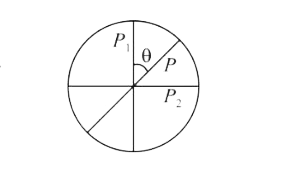A polaroid sheet is rotated in between two crossed polaroids P1andP2 At what θ of pass axis of polaroid sheet with pass-axis of polaroid P1 must be kept so that the final intensity of transmitted light be maximum? (P = polaroid sheet axis)

π4
π6
π3
π2
The correct Answer is:A
Intensity of light after passing through P1beI0
Thus, Intensity of light passing through P2 will be
IP2=(I0cos2)cos2(90∘−θ)=I0cos2θsin2θ=I04sin2θ
For maximum IP2⇒sin2θ=1 ∴ θ=π4
Similar Questions
Knowledge Check
When a polaroid sheet is rotated between two crossed polaroids, the intensity of the transmitted will be maximum, when angle θ between pass axes is
Aπ2B3π4Cπ4D2π3Unpolarised light passes through two polaroids, the axis of one is vertical and that of the other is at 45∘ to the vertical. Then, the intensity of the transmitted light is
AI0)4BI0)8CI0DI0)2Find the final intensity of light (I"), if the angle between the axes of two polaroids is 60∘.
 A3I02BI02CI04DI08
A3I02BI02CI04DI08
Define the term 'linearly polarised light'.
When does the intensity of transmitted light become maximum, when a polaroid sheet is rotated between two crossed polaroids ?
View SolutionHow does an unpolarised light get polarised when passed through a polaroid ?
Two polaroids are set in crossed position. A third polaroid is placed between the two making an angle θ with the pass axis of the first polaroid. Write the expression for the intensity of light transmitted from the second polaroid. in what orientations will the transmitted intensity be (i) minimum and (ii) maximum ?
View SolutionTwo 'crossed' polaroids A and B are placed in the path of a light-beam. In between these, a third polaroid is C is placed whose polarisation axis makes an angel θ with a polarisation axis of the polaroid A. If the intensity of light emerging from the poloaroid a is Io then show that the intensity of light emerging from polaroid B will be 14Iosin2θ.
View SolutionLight waves are electromagnetic waves and hence transverse in nature. The electric field in a light wave propagating in free space is perpendicular to the direction of propagation. But there are infinite number of directions perpendicular to the direction of propagation. but there are infinite number of directions perpendicular to the direction of propagation of light. for example if light propagates along x-axis, the electric field may be along y-axis or along the z-axis or along any direction in y-z plane in the ordinary light. However, if electric field →E remains parallel to a fixed direction (say y-axis) then such light is called linearly polarised light.
There are several methods to produce polarised light from the unpolarised light. now-a-days polaroid sheets are commonly used to produce linearly polarised light. a polaroid has long chain of hydrocarbons which become conducting at optical frequencies. when light falls normally on the polaroid sheet, the →E parallel to the chains is absorbed in setting up electric currents in the chains but →E perpendicular to the chain gets transmitted. so, light on passing through the polaroid i.e., the transmitted light become linearly polarised with →E parallel to the transission (pass) axis of polaroid.
If linearly polarised light of intensity 'I' is incident on another polaroid whose pass axis is inclined at an angle θ from pass axis of first polaroid (or transmission axis of →E of linearly polarised light) the intensity of transmitted light It is given as:
It=Icos2θ.
Q. Two polaroids P1andP2 are set with their pass axis inclined at an angle 30∘. if I0 be the light incident on P1, what is the intensity of light transmitted through P2 ?
View SolutionTwo polaroids are placed in the path of unpolarised light of intensity I0 such that no light is emitted from the second polaroid. If a third polaroid, whose pass axis makes an angle θ with the pass axis of first polaroid, is placed between these polaroid then the intensity of the light emerging from the last polaroid will be
View Solution
